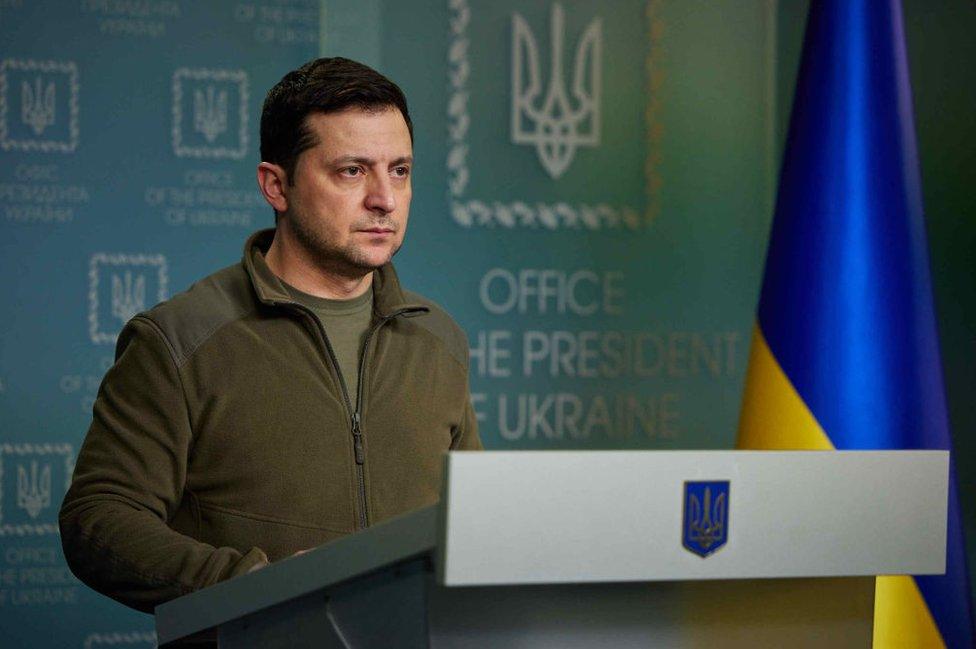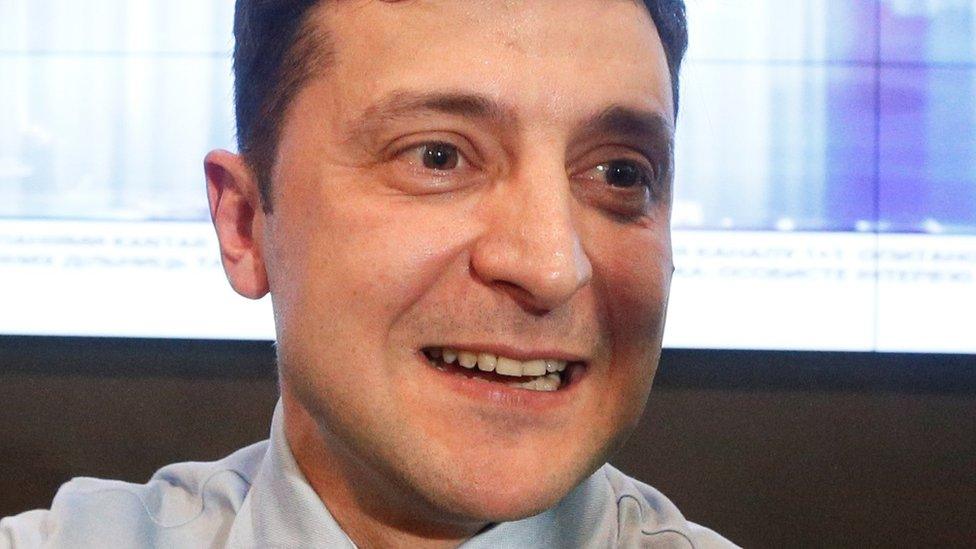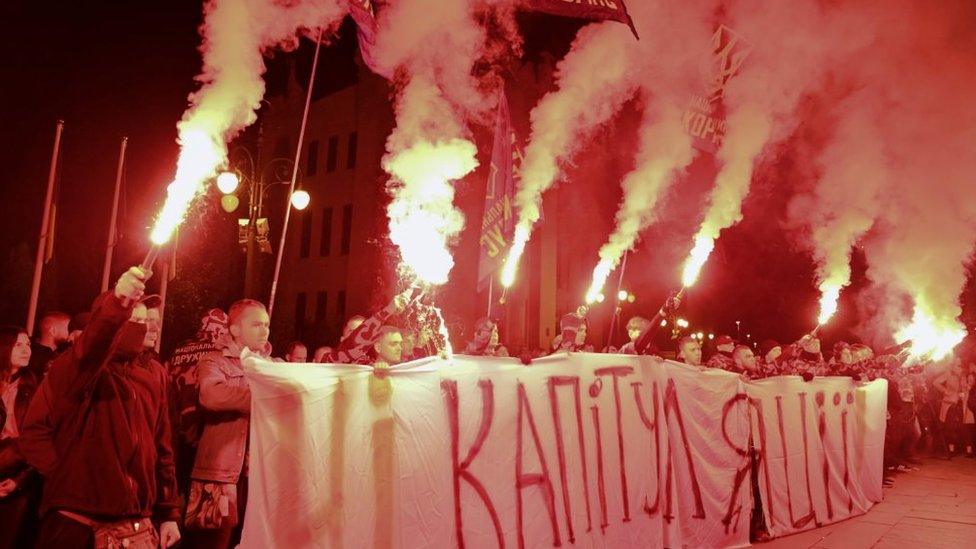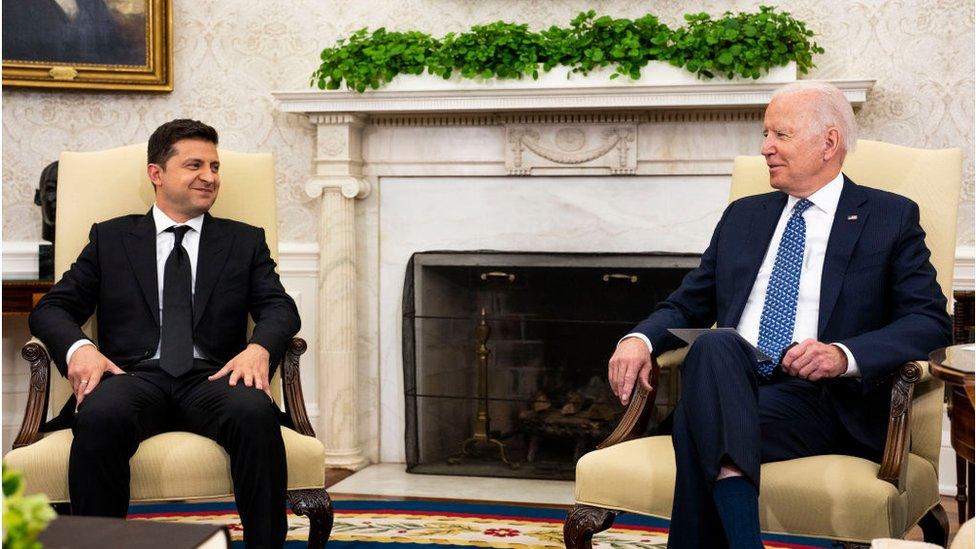Ukraine's Volodymyr Zelensky: The comedian who became a wartime leader
- Published
Zelensky's defiant response to invasion... in 100 seconds
Volodymyr Oleksandrovych Zelensky was a comedian with no political experience when he announced that he would be running in Ukraine's 2019 presidential election.
Six years later, he is an embattled wartime leader navigating a huge geopolitical upheaval as Donald Trump brings to an end years of strong American support for Ukraine.
Zelensky has been a symbol of Ukrainian defiance against Russian aggression. Slava Ukraini, or Glory to Ukraine, has been his battle cry since Moscow launched its full-scale invasion on 24 February 2022.
Much of the world rallied behind him - he received several standing ovations after his address to the US Congress asking for American support.
But just three years later, he finds himself in uncertain territory, with US President Donald Trump calling him a dictator and the US siding with Russia in votes at the UN to mark the third anniversary of the Ukraine war.
Zelensky's trip to Washington at the end of February, during which he was expected to sign an agreement on sharing his country's mineral resources with the US, ended in acrimony. He was told to leave the White House after an angry exchange with Trump and his vice-president, JD Vance.
Zelensky's arrival on the political scene was a case of life imitating art.
Ironically, Zelensky's most celebrated role as a comic actor was playing a school teacher who was catapulted into the presidency on the TV series, Servant of the People.
Cut to real life, and his election candidacy, aged 41, was initially seen by some as a joke - his political party is even called Servant of the People.
But he won with a landslide 73% of the vote, promising to fight corruption and bring peace in the east of Ukraine.
The comedian who would be president
Sceptics feared Zelensky would turn out to be a puppet leader, controlled by oligarch Ihor Kolomoisky who backed his campaign and had been under investigation for fraud and money laundering.
But Zelensky proved to be more independent than his doubters thought, and the anti-corruption drive by his administration has had some success.
Many Ukrainians also viewed Zelensky's rhetoric on the conflict in the eastern Donbas region and relations with Russia as too timid, says communications consultant Yaryna Klyuchkovska.
As the drumbeat of war grew louder, Zelensky continued to emphasise his hopes for a diplomatic solution, even while Ukraine was reporting a rapid increase in ceasefire violations along the front line.
His attempts to negotiate with Russia had only limited success.
There were prisoner exchanges and moves towards implementing parts of a peace process, known as the Minsk agreements, but no breakthrough. Throughout 2020 his approval rating steadily fell.
There was a notable shift in tone at the Munich Security Conference in February 2022, when Zelensky laid bare the threat his country was facing, and accused the West of appeasing a resurgent Russia.
No Ukrainian leader had spoken so bluntly to the West before, according to Ms Klyuchkovska.
Then, on 24 February 2022 - just hours before Russia first began bombarding Ukraine's cities - came a key moment.
In a sober address posted on social media, speaking partly in Russian, Zelensky said he had tried to call Vladimir Putin to avert a war, and had been met by silence.
The two countries didn't need a war, he said, but if Ukrainians came under attack they would defend themselves.
"When you attack us you will see our faces - not our backs, but our faces."
For his next broadcast after Russia had invaded, he wore military fatigues, reflecting the country's David-versus-Goliath struggle.
That evening he made another address, warning Western leaders that if they did not help, tomorrow "war will knock on your doors".
Zelensky's nightly video addresses became a source of hope and comfort for millions of Ukrainians during the ongoing fighting. His ability to connect was perhaps most evident when he posted a defiant video of himself with several top advisers in Kyiv, after Russia falsely claimed he had fled the capital.
"We are here," he repeated. "We are in Kyiv. We are protecting Ukraine."
Zelensky quickly became a national figurehead, with a high of 90% approval ratings in the immediate aftermath of the invasion.

After Russia invaded, Zelensky starting wearing military fatigues, which have become his signature style and a political statement
The war has understandably taken an emotional toll on Zelensky's family. His wife, Olena Zelenska, and their two children spent months living in secret locations for their own safety. The four have spent very little time together since the start of the conflict.
Further afield, Zelensky has seen it as his mission to galvanise support for Ukraine, leaning on his western allies to provide aid and fast-track his country's membership of Nato.
In between visits to the front line, he has spoken with foreign leaders to lobby support and attended conferences across the globe, pleading for help.
One of the most striking and enduring images from the early months of the war was his visit in April 2022 to the outer Kyiv suburb town of Bucha - where Russian troops are suspected of committing hundreds of war crimes.
His first foreign trip after the invasion came in December 2022 when he went to the US to visit then-President Joe Biden - unsurprising given Washington had been Kyiv's largest backer.
During that trip, Zelensky received several standing ovations when he addressed Congress and told them: "Against all odds... Ukraine is alive and kicking" and will "never surrender".
Biden also promised further support to Ukraine, saying the American people were prepared to "have us stand up to bullies".

Years before politics
Born in the central city of Kryvyi Rih, east Ukraine, in 1978
Graduated from Kyiv National Economic University with a law degree
Co-founded a successful TV production company
Focused mainly on his TV and film career until the mid-2010s
Produced shows for a network owned by controversial billionaire Ihor Kolomoisky
Backed by Kolomoisky during his presidential campaign, which worried some Ukrainians

But Zelensky has cut a frustrated figure at times over the speed at which he has received western support - as well as the reluctance to approve the use of some weapons on the front line.
Even in the first few months of the conflict, it was clear there would be pushback from some Republican Party quarters over how much support the US should give.
Three years on, and with a different president in the White House, there appears to be a deepening rift between the two countries.
Zelensky has long maintained that talks about Ukraine's future should be conducted with Ukraine at the table. But the Americans have instead met with Russian officials to discuss the war - and Ukraine wasn't there.
Zelensky has accused the US of helping Putin to "break out of years of isolation" and said Donald Trump lives in a "Russian disinformation space".
Meanwhile, Trump has turned his ire on Zelensky, calling him a "dictator" - echoing Russia's claims - and criticising the fact that Ukraine has not held an election since 2019.
A vote was scheduled for May 2024, but it was suspended because Ukraine has been under martial law since the invasion began, a decision that was broadly backed by the opposition and the Ukrainian population.
Zelensky has suggested he would be willing to resign as leader in return for Ukraine's membership of Nato.
BBC VERIFY: Fact-checking Trump claims about war in Ukraine
UKRAINE IN MAPS: Tracking the war with Russia
Trump also took aim at Zelensky's approval rating. It is true that his popularity has dipped over the years, but as Yaryna Klyuchkovska noted, for someone who started with such a high approval rating - the only way was down.
Even so, while polling is limited in Ukraine because millions have fled and Russia occupies about a fifth of the country, a recent survey suggested Zelensky still has the support of 57% of Ukrainians.
Russia's war on Ukraine has lasted far longer than Moscow intended - Putin had hoped to take Ukraine within a matter of days of launching what it calls its "special military operation".
Three years since the start of the invasion, and while Russia continues to make territorial gains, Ukraine has managed to slow the advance and even mount a counter-offensive inside Russia itself.
Ukraine's future is still uncertain, but Zelensky remains defiant in the face of Russian aggression.
Related topics
- Published22 April 2019

- Published2 October 2019

- Published1 September 2021
